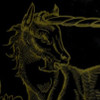



|
|
|
Title | Unicorn: Myth and Reality
| |
Series | ---
| |
Author | Rudiger Robert Beer
| |
Cover Art | Les Lawrence
| |
Publisher | Van Nostrand Reinhold - 1972
| |
First Printing | 1972
| |
Category | Reference
| |
Warnings | ---
| |
Main Characters
|
---
| |
Main Elements | Unicorns
|
|

Though it never roamed the earth, the unicorn has fascinated both storyteller and artist for thousands of years. How and where was this beast of fable created? What contrasting beliefs has it symbolized? What needs did it fulfill for those who believed in it? What as it supposed to have looked like? (The single horn was variously thought to curve as well as grow straight out; to issue from the nose as well as the forehead).
This lavishly illustrated history, the result of over a decade of research, reveals much that is surprising: the existence of the unicorn was so rooted in Grecian culture, for instance, that even Aristotle developed a theory about the singularity of the horn. The author traces the unicorn's first appearance in Europe, centuries before the birth of Christ, to its arrival in The Cloisters in New York and into the pages of twentieth-century poetry books. Its image is brought to life in references to the literature of East and West, through the use of ancient illustrated manuscripts, tapestries, sculptures, woodcuts, engravings, church decorations and achitectual bas-reliefs.

This is my third serious academic treatise on the unicorn that I've read. It's quite accessible to the layman but it's not a light read. Odel Shepard's The Lore of the Unicorn may be the gold standard of unicorn research but this one is equally in depth covering everything from the origins of the unicorn legend, the Virgin myth, the uses of the horn in medicine, and it also covers the unicorn in art in many beautiful full colour images, showing us how the unicorn changed in form over time.
The most interesting thing is that people of medieval times did not think the unicorn a magical creature, in fact while the single horn is of course more powerful than those from the animal having two (with the idea being that the power of two horns combine into one to be twice as potent) it was still just a regular animal. It wasn't supernatural or magical, no more than say an elephant or a giraffe, which if you think about those beasts, are much stranger looking than a horse/goat/gazelle/whatever with a single horn, the unicorn was almost mundane.
The unicorn represented many things in art, often conflicting. It could represent virignity and chastity (with the virgin capture legend) or it could represent the opposite (it does have a big phallic object on it's head after all). It represented courage, as a creature that could not be captured alive, and thus appears on many a coat of arms. Sometimes it represented the devil, sometimes it represented Christ. It represented medicine, a symbol often appearing in apothecary shops.
For a creature that never existed, it caused a lot of debate among scholars. Some saying it could not possibly real (in fact the bone structure of the skull has determined that a single horn in the middle would in fact be impossible) while others pointing out various facts including it's inclusion in the Bible (a Greek mistranslation of a Hebrew word), and the evidence of physical horns (usually narwhal tusks).
But no matter how you look at it, the unicorn is fascinating legend that continues to fascinate us now. While we don't tend to believe it in anymore, and we have turned a beast into a magical creature of light and purity and rainbows, it still feeds our imagination and enchants us in our dreams. Our world would be a lesser thing were it not for the presence of the unicorn.
|